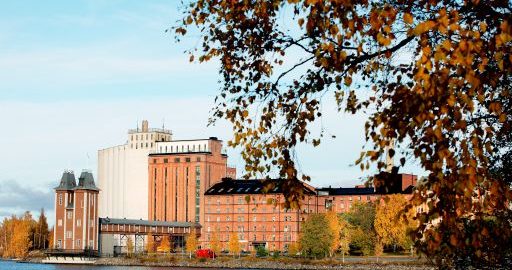Jeg ankommer et Tromsø badet i sol, som viser seg fra sin beste side og blir møtt av dekanen, den ansvarlige for internasjonal utveksling, forskningsteamet for likestilling i kunstfagene i Norge, medlem i komité for kjønnsbalanse og mangfold i forskning for perioden 2018-20 og en kollega jeg skal overta åtte timer undervisningen til. Denne heftige og begeistrede gjengen følger meg tett faglig og sosialt i en tettpakket og uforglemmelig uke på Eramus-utveksling i Nordens Paris.
Jeg underviser i musikkhistorie denne uka. De lokale utøvende musikkstudentene og jeg kobler teori med praksis, så de sørger for levende musikk og jukeboks med gode innspillinger til undervisningen. For sette kvinnelige komponister på dagsordenen, undervises det i år ikke i Mozart og et par andre kanoniserte døde mannlige komponister, et modig valg. Musikkhistorien undervises heller ikke kronologisk tidsmessig. Den ene av undervisningsøktene våre handler om musikk og nasjonalisme: Studentene har forberedt seg med å gå på Nordlyskonserten Å leve det er å kjempe, i Ishavskatedralen, Tromsøs kanskje mest kjente signaturbygg. Den norske fiolinisten Atle Sponberg er gjest på videolink og forteller oss om arbeidet med konserten. Han har sendt tekster som en skuespiller framførte på konserten om komponistene på programmet. I økta arbeider vi hovedsakelig med musikk av Signe Lund, som var nazist med statsstipend under krigsårene. Dermed er ikke bare genusperspektiver, men også utøvende perspektiver og etiske dilemmaer knyttet til å arbeide som musiker og komponist under krigsårene på agendaen. En annen undervisningsøkt er viet Fanny Hensel og hennes påskesonate, som man inntil en amerikansk doktorgradsstudent utførte et imponerende stykke detektivarbeid, trodde var komponert av hennes yngre bror Felix Mendelssohn. En slik inngang til arbeid med historiske kilder og musikkanalyse engasjerer virkelig studentene, som ser hvordan man blir forsker og dermed påvirker musikkhistorieskrivingen. I sine evalueringer av undervisningen er de også meget fornøyde med å ha gjestelærer.
De og lærerne sørger for mye levende musikk, den ene konserten og forelesningen med fakultetets personale og studenter avløser den andre i Tromsøs kulturhus. Dessuten har jeg viktige faglige møter med forskningsgrupper, der vi utveksler forskning og bygger nettverk videre. Paraplygruppen MAGIC (Multimodality, Art, and Gender in Intersiciplinary Communication), sikter bredt, har nettopp startet prosessen med å diskutere metodologier samt hvor de kan søke forskningsmidler. Et delmål for gruppa er å spille en rolle i studentenes læringsopplevelser: De oppmuntrer studenter i slutten av kandidatstudiene og i prosesser med å skrive masteroppgaver til å delta. På sikt ser gruppa dessuten for seg å bidra til fakultetets master-blokker, så vel som å være del av mulige nye mastergradsprogram, et eksempel til etterfølgelse.
«Kjønn og skjønn i kunstfag – «nye» karrierebarrierer for kvinner» er også et ganske forbilledlig prosjekt og drives av en meget slagkraftig og framgangsrik gjeng som er i ferd med å avslutte et prosjekt med støtte fra Norges forskningsråds BALANSE-program. Her deltar en tidligere doktorgradsstudent jeg har veiledet, nå som postdoktor. Prosjektet startet med kickoff for samtlige ansatte og ledelsen ved fakultetet og har sørget for suksessiv implementering av endringer som skal bidra til mer likestilling og mangfold blant studenter og ansatte. Slik ble fakultetet tildelt Universitetets likestillingspris. Gruppa har blant annet studert anbefalingsbrev i tilsettings- og opprykksprosesser i musikkfagutdanning. Den har utforsket hvordan institusjonene kan sørge for at kvinner hyres inn som eksterne eksperter eller på timebasis (noe som ikke uytlyses), hvordan kvinner kan slippe akademisk «husarbeid», til fordel for mer meritterende oppdrag, hvordan skaffe mer balanse og mangfold blant søkere til utlyste stillinger og hvordan alle involverte i prosessene kan tenke mer likestilling og mangfold i alle ledd. Fakultetet har vært pådriver for å få kvinnelige komponister inn på det nasjonale repertoaret ved prøvespill til høyere musikkutdanning, hatt flere leder- og personalseminar om likestilling og mangfold, arbeidet for mer balanse i innholdet i egen undervisning og delt ut studentenes likestillingspris. I april reiser jeg tilbake for å delta i sluttkonferansen til prosjektet, der jeg har blitt med i referansegruppen og vi regner med å holde livlig kontakt videre.






